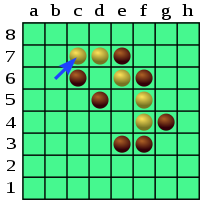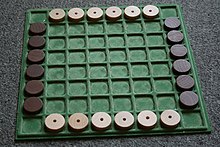Lines of Action
Lines of Action (LOA) is a board game in the abstract strategy game for two players by the game designer Claude Soucie . The rules of the game were published in 1969, and it was first published as a box game in 1988. In the German edition of Hexagames , LOA was on the Game of the Year selection list for 1988.
History
LOA was very popular in its beginnings through the publication in Sid Sackson's A Gamut of Games from 1969 (in German games different from others 1983). In North America, it gained a certain degree of notoriety among insiders, in Europe it remained largely unknown.
In recent years, like chess , it has been found that excellent computer programs can beat human players. Right now, the world's best LOA player is software called MIA . MIA won the 8th (2003), 9th (2004) and 11th Computer Game Olympiad (2006).
Claude Soucie, the inventor of LOA has long passed away, while his game is moving more and more people. Certain detailed questions in the rules had to be clarified. Game designer Sid Sackson was very close to Claude Soucie, so his suggestions in disputes have mostly been accepted.
regulate
General
Lines of Action is played on a standard chess board. The same alphanumeric notation is also used for the rows and columns.
Each player moves twelve pieces, which are placed in the starting position as shown in the graphic:

Rules for pulling and hitting
- The players take turns, Black begins.
- The stones can be moved horizontally, vertically or diagonally.
- A piece moves exactly as far as there are pieces - own and opponent's - on the move line, i.e. on the line ( chess : "row"), column (chess: "line") or diagonal along which the stone is moved. The moving piece also counts, as is any piece that may have been struck in this move.
- A token may end its turn on the space of an opposing stone. That one is defeated and removed from the game.
- A token can jump over its own stones, but not opposing ones.
Goal of the game
- The aim of the game is to bring your own pieces, which are still on the board, into a coherent formation. This connection of the stones can be achieved in all eight directions, horizontally, vertically or diagonally.
- If this win condition is met for both players at the same time, this is either a tie or a win for the player who draws, depending on the agreed version of the rule.
- If a player's penultimate stone is captured, his last stone is considered a contiguous group and that player wins (if the opponent does not also connect his stones at the same time).
In the diagram below, White has just drawn b6-c7 and thus fulfilled the win condition.

tactics
In the following diagram it is Black's turn. White threatens to win in two moves:
- a2-c2
- c2-e2
What can Black do about it?
The move b4-d2 would help White. On the 2nd row you would then find three stones, which would allow White to move a2: d2 and thus win.
By instead moving b3-c2 with the aim of blocking the 2nd row for White, you are giving him the opportunity to play a2: d5, which was not possible before.
Black could also move c8: f5 and separate the piece g5 from the rest of the white group. White can then renew the threat with g5-f6.

Trying out other possible moves sharpens the eye for the finesse of this game.
variants
The board game Zen l'initié (DJ Games) is based on the same game mechanism as LOA : the draw and the aim of the game are identical. The board comprises 11 × 11 fields and the placement of the starting position has been changed. There is also a neutral red token that can be drawn or caught by both players. As long as he is in the game, he must belong to the winning position.
Zen l'initié was first presented at the Festival des jeux de Cannes in 1997. At the request of Claude Soucie's widow, the makers added his name to the box.
Like the original Lines of Action on an 8 × 8 board with 12 stones of each color is scrambled eggs (translated: scrambled eggs ) played. At the start of the game, the stones are also placed along the edges, leaving out the corner fields, but always alternating a white and a black stone. The other rules are the same.
literature
- Sid Sackson: Spiele different than others dtv, Munich 1983 ISBN 3-423-10186-5
- Sid Sackson, A Gamut of Games , ISBN 0-486-27347-4
Individual evidence
- ↑ Mark's LOA homepage. September 21, 2015, accessed on September 2, 2019 .
- ↑ Get Lines Of Action. Microsoft, accessed September 2, 2019 .
